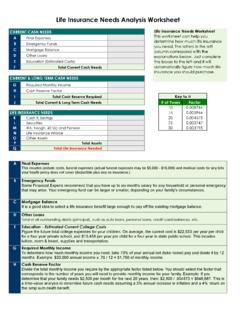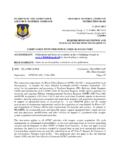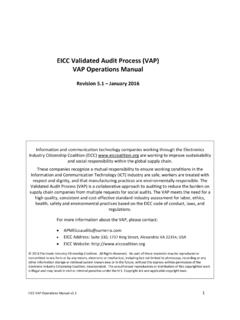Transcription of MF1070 Contract Hog Production - uwagec.org
1 Kansas State University Agricultural Experiment Station and Cooperative Extension ServiceMF-1070 Hog Enterprise ManagementDEPARTMENT OF AGRICULTURAL ECONOMICSC ontract hog produc-tion involves an agreementbetween a contractor and agrower. The contractorowns and provides feederpigs for feeder pig finish-ing contracts and breedingstock for feeder pigproduction contracts, andtypically bears the costsassociated with feed,medication, and transporta-tion. Growers raise thepigs in their own facilities,and are compensated on a fee basis. Growers coststypically include labor, facility costs, repairs, utilities,insurance, and property in Contract hog Production has increased inrecent years. This growing interest in Contract produc-tion is related to the risks associated with independentproduction, the availability of financing throughcontracting, and the stability of Contract returns.
2 Thisbulletin can be used to evaluate the profitability andfeasibility of Contract and disadvantagesPotential contractors include investors, feed compa-nies, and farmers. Contractors find Contract arrange-ments attractive for several reasons. One reason forcontracting may be to utilize excess feed productioncapacity. Contractors may also find Contract productionto be an effective means of reducing capital require-ments and risk. Another reason for contracting hogsmay be to improve the uniformity of feeder pigs ormarket hogs sold. Finally, a contractor may findcontract Production an appealing way to take advantageof the economies of size associated with buying andselling breeding stock and market enter Production contracts for variousreasons.
3 One of the primary reasons is to reduce contracts typically transfer the risks associ-ated with changes in feed costs, breeding stock prices,feeder pig prices, andmarket hog prices to thecontractor. The growerstill bears the risk associ-ated with owning facili-ties. A second reasongrowers enter a contractarrangement is to obtainfinancing for buildingsand equipment. Manycontractors help build thefacilities and providefacility loans to third reason growersenter Production contracts is to stabilize profits andcash flow per are disadvantages to Production contracts forboth contractors and growers. Contractors that chooseinefficient producers may lose a substantial number ofhogs and money before the problem is may find it difficult to save enough moneyfrom the fixed payment to build their own to a survey by Rhodes and Grimes, 56percent of all Contract growers in 1991 indicatedcontract payments would not cover the costs associatedwith replacing facilities.
4 Thus, the potential for con-tract growers to move into an independent ownershipsituation is limited. Another potential problem from thegrower s perspective is Contract length. Contract lengthmay be substantially shorter than the time it takes topay for facilities. If this is the case, producers need tothink about how they will pay for facilities if thecontract is hog contractsWhen evaluating a Contract , growers need to remem-ber that no one Contract is best for everyone. Thereare many different types of contracts. Payment method,cost sharing, and Production bonuses vary from onecontract to another. Whatever the Contract provisions,producers and contractors should make sure that theContractHogProduction:An economic evaluationMichael R.
5 LangemeierExtension Agricultural Economist,Livestock Production2contract rewards them for what they do best. Forexample, Production bonuses that are too optimistic will not benefit even an above average evaluation of hog Production contractsshould include an analysis of the profitability, feasibility,and riskiness of the Contract . The profitability of contractproduction can be assessed by comparing contractreturns to that of independent Production . Table 1presents several different measures of historical averagereturns for farrow-to-finish, feeder pig finishing, andfeeder pig producing operations inKansas. The return measures inTable 1 were computed usingaverage levels of performance overa 10-year period. The negativereturn above all costs for feeder pigproduction indicates that thisenterprise did not generate enoughincome to cover labor and manage-ment charges over the ten yearperiod.
6 At the same level ofproduction and efficiency, contractproduction would be expected togenerate lower returns thanindependent Production sincecontract Production involves alower capital investment, lessmanagement, and less feasibility oraffordability of contractproduction is another impor-tant consideration. Feasibilityrefers to the ability to makeloan payments and pay cashexpenses. One way to evalu-ate feasibility is to calculatethe percent of the investmentthat can be financed with netcash is an important consid-eration in any economicanalysis of Contract or inde-pendent hog Production . Thetwo major risks involved inhog Production are the risksassociated with investing inspecialized facilities and therisks associated with fluctuat-ing Contract and indepen-dent hog producers face therisks associated with investing in specialized often hog buildings and facilities bring less onthe market than their value to the firm selling the hogbuildings.
7 Because of a relatively thin market and hightransaction costs, the liquidation values for hog build-ings are generally substantially lower than their re-placement cost. Suter estimates that hog facilities 1 to 3years old are worth only about 50 to 60 percent of theirreplacement costs. Hog facilities 3 to 5 years old areTable Measures for Swine Operations in Kansas, 1983-1992 MeasureaFarrow toFeeder PigFeeder PigFinishProducingFinishing(Per Litter) (Per Litter)(Per Head) Average returns above all$ $ $ variable costs except labor Average returns above$ $ $ variable costs Average returns to labor$ $ $ and managementb Average returns above total$ $ $ costsSource: KSU Quarterly Swine Return Variable costs include feed, labor, veterinarian costs, supplies, marketing costs, utilities,repairs, and miscellaneous costs.
8 Fixed costs include depreciation and interest onbuildings, equipment, and breeding Average returns to labor and management are calculated by adding operator and hiredlabor to average returns above total Distribution of Returns to Labor and Management forFarrow-to-Finish Operations in Kansas from 1983-1992 Returns Per Litter Percent of Quarters Returns greater than $ Returns greater than $ Returns greater than $ Returns greater than $ Returns greater than $ Returns greater than $ Returns greater than Returns less than Loss greater than $ Loss greater than $ : KSU Quarterly Swine Return only about 35 to 50 percent of their replacementcost. When hog facilities are 6 to 10 years old, they areworth only about 20 to 30 percent of their replacementcost.
9 Facilities older than 10 years are difficult to sellfor any economic value. Suter points out that theseestimates apply to areas where hog Production isprevalent. Facilities located in areas where hog produc-tion is not prevalent may be worth substantially lessthan these estimates. For example, it is common in theSouthern Plains for facilities to sit idle because asuitable buyer cannot be risk is the largest risk that Contract hogproducers face. Most contracts have a shorter durationthan the useful life of the hog facilities which increasesthe grower s exposure to investment risk. A grower needsto factor this added risk into the decision to produce hogsunder Contract and needs to deter-mine what will happen if thecontract is producers do not facerisks associated with fluctuations ininput and output prices.
10 Unlessperformance or costs change fromone period to the next, contractreturns are flat. The probability ofreturns being below a specific targetis one measure of risk (Fleiser).This measure of risk focuses on thenegative consequences associatedwith a specific action. Tables 2through 4 present the estimateddistribution of returns to labor andmanagement for independentoperations in Kansas from 1983 to1992. For farrow-to-finish produc-ers, returns were below breakevenduring 10 percent of the quartersfrom 1983 to 1992. In contrast, forfeeder pig finishers and feeder pigproducers, returns were belowbreakeven for and percentof the quarters, respectively. Usingthis information, it is evident thatfinishing or producing feeder pigsindependently is more risky thanindependent farrow-to-finishproduction since the probability ofreturns being below breakeven ishigher for these two modes things should be noted when using the informa-tion in Tables 1 through 4.











